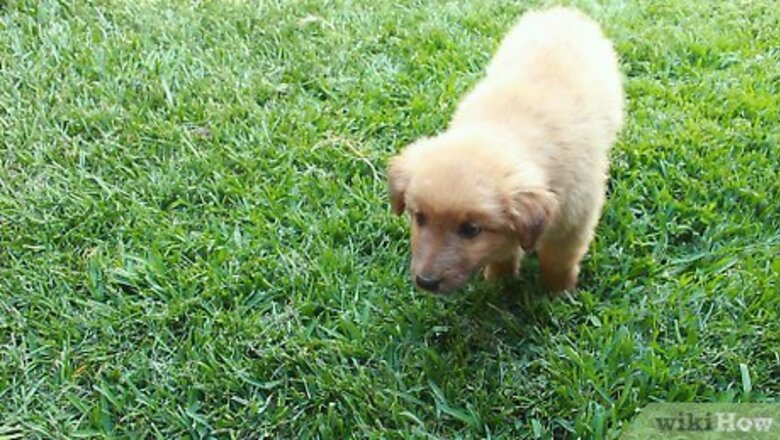
views
Giving Your Puppy the Proper Environment
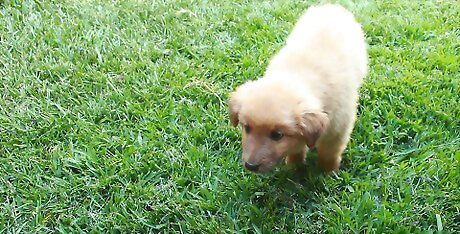
Keep your expectations reasonable. Puppies don’t have an inherent understanding of what humans consider right and wrong. They can learn many behaviors, though. A puppy doesn’t understand that it is “bad” behavior to urinate on your carpet. To your puppy, the carpet is an acceptable surface, just like the grass outside. You must teach the puppy the better choice.
Force the initial happy accidents. The initial act of housebreaking your dog is more fortuitous than anything. Taking him out to go often will lead to him going outside by coincidence. He will start to understand the behavior you want to cultivate when you praise him for the happy accident. Though, it will still take time and many repetitions. If you catch your puppy eliminating in the house, interrupt the act. Use an interrupting command such as, “Outside!” Don’t yell or scold when issuing the command. Just use the command to interrupt the puppy and stop him from going. Scoop the puppy up and take him to his designated potty spot outside. If he finishes in the correct spot, issue the appropriate praise and/or treats. Be sure to use the same place outside each time. Taking your puppy out on a leash is the ideal method for keeping them to one area.
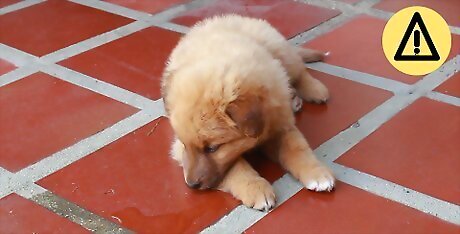
Avoid punishing your puppy for accidents. Your puppy won’t understand why you’re punishing. Scolding and physical responses will only instill fear in your puppy. This can often make the puppy try to eliminate in hidden areas around the home away from your presence. Serious behavior problems beyond housebreaking can develop when you don’t use positive training methods.

Know nature's bladder boundaries. The age of your puppy has a bearing on the puppy's ability to be house-trained and the amount of time you can take between potty breaks. Do not take accidents as being difficult. Compare them to a baby still learning to control his bladder. A general guide is as follows: Between 8 and 16 weeks of age is considered the prime socialization period for puppies. At this point, your puppy can only hold his bladder for around 2 hours. It is also the best time to start housebreaking. At 16 weeks, a puppy can usually hold his bladder for up to four hours. Prior to this, the bladder can withstand about 2 hours before the puppy must go. At 4-6 months, puppies in this age group can often seem "half" house trained due to their ability to be easily distracted. He's likely to want to explore the world, which means chasing a moth might prevent him from eliminating when you take him to his spot. By now, a puppy of four months can wait about four to five hours before needing to eliminate, while a puppy of six months can go as long as six or seven hours. When a dog reaches 6-12 months, sexual maturity can cause males to raise their legs and pee on furniture, while females can come on heat. The bladder can cope with seven to eight hours before needing to eliminate. At 12-24 months, your puppy may not be fully mature yet depending on the breed. Hopefully you've established house training long before this age, but if not, you can still do so, even for adult dogs. Although not impossible, housebreaking older dogs that have developed bad habits generally requires much more energy and diligence on your part than doing it “right” the first time as a puppy.

Note the breed of your dog. Larger dogs tend to be easier to house train than small dogs. Smaller dogs need to go more frequently (with tinier digestive systems). Smaller dogs can also get into places to eliminate where you may not notice or be able to find until a bad habit has been established. Limit your dog’s access to the whole house to prevent this.
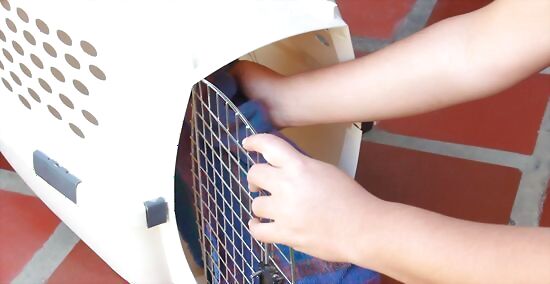
Acquire a crate or “den.” Just like people, puppies don’t want to eliminate near the areas they eat and sleep. Crate training your puppy is a great way to help the puppy learn bladder control. The crate also gives security. When you're around, leave the crate door open for going in and out as needed. Leave toys, treats, and comfy bedding inside. The crate should be a happy place, not a place for punishment. Some dogs take to a crate right away, and others need a more gradual introduction to the crate. At some point in your dog’s life, he will probably have to get into a crate. The vet, travel, and grooming visits all require your dog to be confined. It is better to get him used to one while he is young. Puppies under 6 months old should never be left in their crate for more than 3 to 4 hours regardless of bladder control. They need more interaction. If you have to work during the day, hire a dog-walking service to come let your puppy out appropriately. When you come home after crating your puppy, you can immediately take your puppy outside and not give him the opportunity to make a mistake in the house.
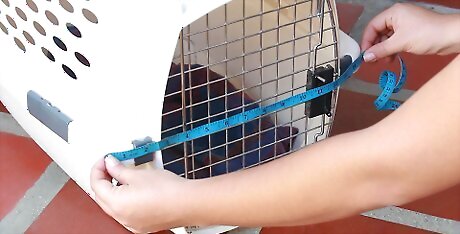
Size the crate appropriately. Size the crate so the puppy can stand up, turn around, and lie down. It should not be so big that the puppy can eliminate in one corner and sleep in another. The idea is to use the natural instinct to avoid sleeping in your own mess to help with the housebreaking process. If you have a large breed puppy, there are crates designed to “grow” with your puppy, so you don’t have to waste money buying bigger sizes as they age. If you don’t have a crate, you can use a section of your bathroom partitioned with a baby gate.

Choose a designated area for your puppy to "go" before bringing him home. This spot might be somewhere in the backyard, next to a structure that provides shelter from wind, or some other suitable place in the garden. Wherever it is, have a firm commitment to it before getting the puppy. You don't want to create inconsistent messages by shifting his toilet around the yard while you make up your mind.
Developing a Routine
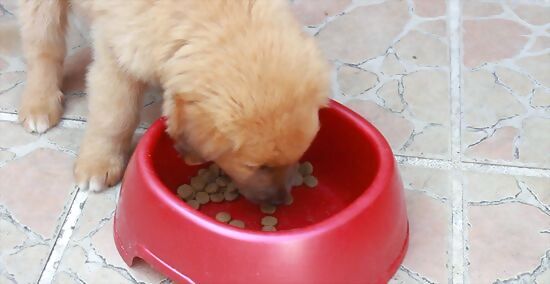
Develop a feeding schedule. Putting your puppy on a feeding schedule can make your efforts much more successful. A puppy allowed to eat whenever he wants will make house training difficult. Also, developing a schedule to take your puppy outside will make it easier on you. Always take a puppy outside within 15 to 20 minutes after meals like clockwork.

Develop a potty schedule. The most important thing of all when house training a puppy (or dog) is consistency. If you are consistent, and do the same thing and expect the same action every single time, your puppy will catch on very quickly. On the other hand, changing your actions and expectations will confuse your puppy. Create a predictable and consistent routine for your puppy. Take your puppy out: When he wakes up in the morning—or before if you manage to get up before the puppy. After each and every meal. Puppies usually need to eliminate within 20 minutes of eating. After each and every nap. After each and every play period. Before he goes to bed for the night. Puppies between 8 and 14 weeks of age will likely need to eliminate during the night. Keep them crated in your bedroom so that you can hear them whine to be let out. Keep the leash, your slippers, and your robe at the ready.
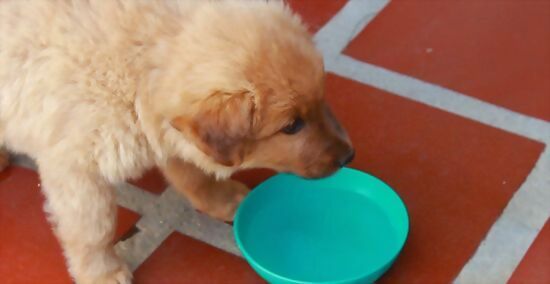
Start housebreaking your puppy immediately. After he has been introduced to his new surroundings, give him a drink of water and immediately take him outside to the predetermined spot.
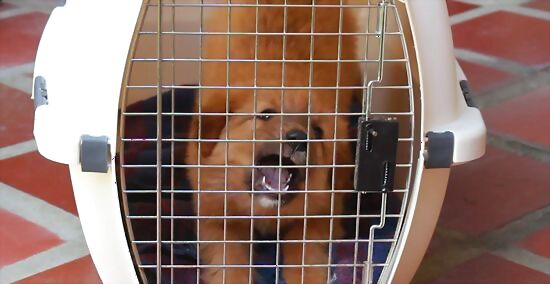
Watch for signs. Your puppy may start to understand that he should eliminate outside before he understands how to let you know he needs to go. Watch for telltale signs that a puppy has a full bladder. Look for: barking or scratching at the door through which you take your puppy out, squatting, restlessness, and sniffing around or circling. If you observe one of these behaviors, especially when you haven’t taken your puppy out recently, then it’s probably time for him to go.
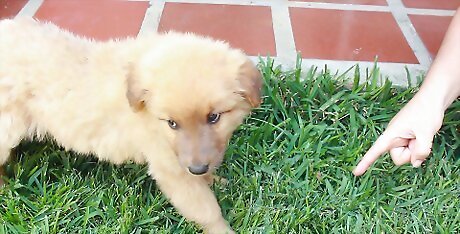
Associate a command with eliminating. In addition to taking your puppy to a designated spot consistently, you may also want to develop a specific command that your puppy can associate with a potty break, such as, "Go potty," "Hurry up,” or whatever you choose.
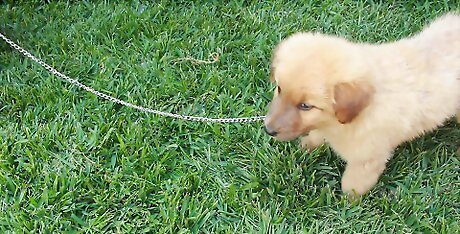
Use this single command consistently. Make sure you only use the assigned potty command for the process of housebreaking. Use it every time you take the puppy out. This allows the puppy to associate this act with the exact command. This will help in the future when traveling, visiting relatives/friends, etc.
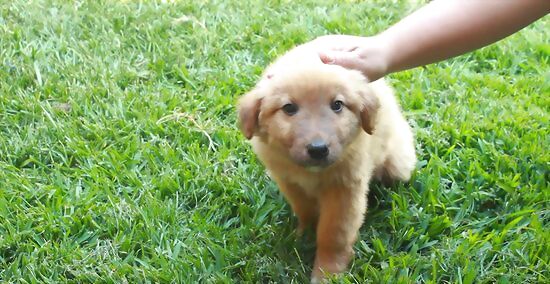
Praise your puppy as soon as he finishes. In order for a puppy to associate the praise with the act, praise him right after he finishes before going back inside. Praise the puppy after he finishes and don’t interrupt the “flow.” Some puppies are so sensitive that they may stop in the middle of eliminating if you praise them too soon. They may even think that you just wanted them to squat in order to get a treat. The timing of praise is important. Remember that freedom is a reward too. Have some fun playing after the puppy has eliminated. You don’t want the puppy to think the fun stops as soon as he eliminates. You want the fun to continue so the puppy wants to hurry up and eliminate and start the fun stuff.

Help force the correct behavior without scolding or punishment. Whenever you take puppy out at a designated time, if the puppy eliminates within 3-5 minutes, praise them and place them in the pen surrounding the crate giving them more freedom. If they do not eliminate within 3-5 minutes, place the puppy inside the crate and close the door. Leave them crated for 15-20 minutes and stay close by. After the short waiting period, take the puppy outside again, if they eliminate, they get more freedom in the larger area. If they do not, they go back in the crate. Puppy will whine instead of going in the crate, so by paying attention, you can help force the proper behavior, allowing you to then reward puppy and show the puppy the extra freedom that comes from the appropriate behavior.

Get everyone involved. If you live by yourself with your puppy, this step will be easy. If your puppy lives in a house with more than one person, make sure that everyone is taking the steps to make the house training process quick and easy. The closer everyone sticks to the plan, the faster the training will progress.
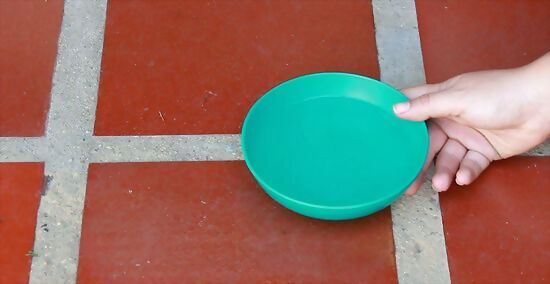
Take up the puppy's water early in the evening. Roughly 2.5 hours before bedtime, take up your puppy’s water dish. This will help ensure that puppy’s last trip out just before bed is good enough to last overnight. Most puppies can sleep for approximately seven hours without having to eliminate, so if you take the water dish up well before bed, then your puppy should have fewer accidents overnight. If your puppy does wake you up in the night because he needs to go, keep the trip out short and to the point. If you turn on too many lights or play at all, then your puppy will think it’s play time and might start to think it’s okay to wake you up for that instead of just potty breaks. Simply take him out and then return him to his bed.
Clean up any accidents quickly and thoroughly. Hardwood and tile floors should be wiped cleaned and sprayed with a disinfectant. Carpets need to be cleaned with a carpet cleaner. This is probably the most important step because dogs have such a great sense of smell. If they can still smell the urine or feces, they will continue to eliminate in the same spot. This is also why the dog should remain on leash inside the house for many months before allowing free range of the whole house. Many people get commercial cleaners at the supermarket. Many of these products contain ammonia. Ammonia smells like urine to your dog. So if your dog urinates on the carpet and you clean with an ammonia product, your dog will come back to that spot and think that a strange dog has gone on the carpet. Your dog will eliminate again on that same spot to cover it. Commercially produced pet mess cleaners contain special enzymes that eradicate the urine odor that attracts the puppy back to the same spot. These can be purchased from pet stores, online sources, your veterinarian, and discount department stores. They are the most effective means of removing, not just covering up, the odor. Some people say that white, distilled vinegar and water work well when followed up with baking soda.
Incorporating Unsupervised Time

Keep your puppy confined initially. Do your best to set the puppy up for success and minimize the opportunities to have “accidents” by using crates, dog pens, baby gates, and leashes to control the areas to which your puppy has access. The area surrounding the crate does not have to be much bigger that four to six feet around when the puppies are small. The area around the crate will increase gradually as the dog gets more housebroken and as large breed puppies get bigger. The more control the dog has, the more “freedom” they earn.

Let your puppy be free in the house while dragging a short leash with supervision. Allow longer periods only when you are sure he will ask to go out when he has to go. This strategy should not take more than two weeks for him to get the picture.
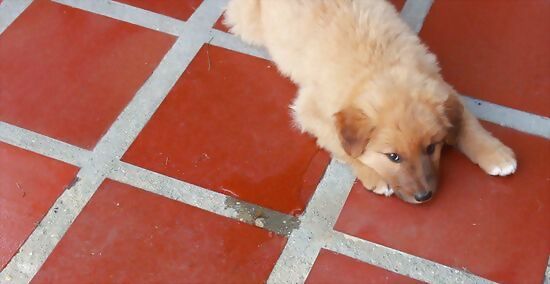
Don't be surprised by “reversions." Your puppy may revert to eliminating inside again after you thought he was trained. This can happen for a number of reasons, such as sexual maturity, change of routine, curiosity overwhelming the need to go at the usual time, etc. Resume the consistent routine you used to housebreak your puppy. He will quickly start obeying the routine again.
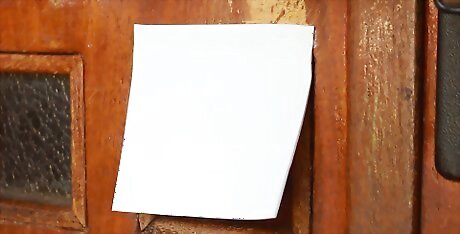
Have a flap door for your puppy. A doggie door is great if you have a proper fence (one that a puppy cannot get under or over) and a gate. Even if you do have a proper fence, be aware of area wild animals that might eat your puppy such as coyotes, etc. Don't leave your dog unattended outside for long periods of time.
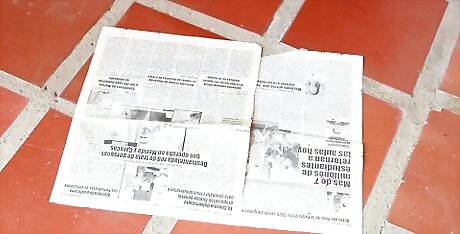
Spread newspapers for your puppy to use. If you don’t have a backyard, a doggie door, or someone who can come let your puppy out while you’re away, you can still use a paper-training method to get a puppy to eliminate in a designated indoor spot. This is just an extra precaution in case the puppy needs to go and cannot wait for you to return home. Place newspaper or a small, accessible box out for the puppy. Since the puppy will want to eliminate in a spot where he can smell previous urine or feces, you can place the rags you used to clean up previous accidents in the box. Some people hold that spreading newspapers suggests that peeing in the house is acceptable. They therefore advocate skipping the newspaper and dealing with any messes. Every owner has to start somewhere. If that means cleaning up a few messes, then that's what's going to be best for your dog and family. Using newspapers may delay the process a bit, but if you gradually decrease the size of the newspapered area and eliminate messes in undesignated areas of the house completely, you will still be successful. You will be using confinement to a smaller area to limit the puppy’s access to the whole house.
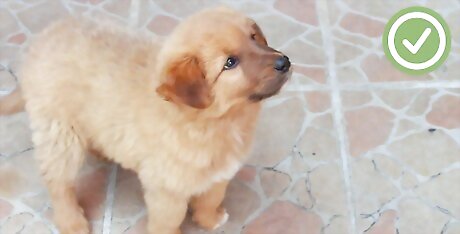
Have somebody look after your puppy. If you go on trips, have somebody look after the puppy. If you live with your family or friends, have them look after him. If your whole family has gone, have somebody who knows about puppies come down and babysit. Tell him or her your schedule, where they sleep, what to feed them, what not to feed them, etc. You can also use a kennel—a place where people look after dogs/puppies while you are gone. Remember, that if the puppy is “forced” to eliminate in the kennel because of the boarding facility’s schedule, you will have taken a large step backward in the training process. Both options have pluses and minuses you will need to consider for your situation.













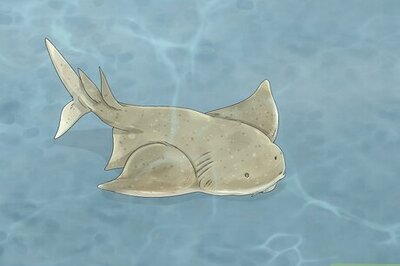
Comments
0 comment